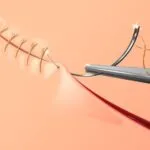A fissure, often known as an anal fissure, is a small tear or cut in the anus lining. This rip results in uncomfortable bowel movements, itchiness, bleeding, and frequently foul-smelling discharge.
The anal canal tears and forms a fissure when it expands past its breaking point. The passage of large, irregularly shaped, hard stools during bowel movements may be to blame for the stretching of the anal canal.

Fissure is diagnosed by a physical examination of the anal area. To find out the extent of the tear, the doctor might perform an anoscopy, a flexible sigmoidoscopy, or a colonoscopy depending upon the patient.

In the Lateral Internal Sphincterotomy (LIS) surgery, the muscles encircling the anus are either cut or stretched in order to cure the fissure. Typically, people fear this fissure surgery because it is so unpleasant. However, the process is completely PAINLESS & BLOODLESS when carried out with a fissure laser treatment.
Laser surgery for fissure lasts only 30 minutes. The patient is released from the hospital within 24-48 hours after the therapy is completed as a DAY CARE PROCEDURE. The patient seldom feels any pain during laser treatment for fissure, which is VERY MINIMALLY INVASIVE. It is a long-lasting treatment for fissures, but the patient must adhere to all the doctor's directions to prevent any consequences. The greatest alternative is unquestionably painless laser treatment therapy. Patients experience immediate alleviation thanks to this medication.
| FEATURES | LASER FISSURE SURGERY | OPEN SURGERY |
|---|---|---|
| Cuts and Wounds | No | Yes |
| Bleeding due to Cuts and Stitches | Very Less | More Bleeding |
| Diet Restrictions | No | Yes |
| Success Rate | High | Low |
| Risk of Infection | Very Less | High |
| Rest after Surgery | Can Resume Work | 1-2 Months Rest |
| Recovery | Fast | Time Taking |
| Pain | Painless | Painfull |
| Recurrence | No | Yes |

Laser Fissure Surgery lasts 10-12 minutes only and may be easily planned as a Day Care Procedure.

Laser Fissure Surgery involves a bare laser fiber making a small incision. There are no big cuts or wounds to heal afterwards making the procedure painless.

Laser Fissure Surgery is carried out through a minute hole in range of around 400-600 μm making the procedure completely minimally invasive.

Laser Fissure Surgery does not involve any big cuts due to use of laser fiber and is practically bloodless.

As the size of laser fiber incision is very small, Laser Fissure Surgery does not require any sutures afterwards.

As there are no big cuts, or wounds, and not even sutures, Laser Fissure Surgery is completely scarless and leaves aesthetically pleasing results.
Acute or chronic anal fissures are both possible. A simple rip in the anus may be the appearance of acute (recent onset) fissures. On the other hand, chronic fissures can last longer than 8 to 12 weeks and may include swelling and scar tissue. Chronic fissures may be more challenging to heal and may also have an additional tissue just inside the anal canal, known as a hypertrophied papilla, as well as an external lump (called a sentinel pile or skin tag) connected with the tear disclosed in the laser fissure surgery.
Fissures typically appear in the anterior (front) midline of the anus (approximately 10-15%) and the posterior (back) midline (about 85-90%) of the anus. A small percentage of patients might, however, genuinely have fissures in both the front and the rear. The risk of complications from other disorders may increase if fissures are found elsewhere (off to the side), necessitating a thorough inspection of fissure treatment.
During bowel motions, anal fissures frequently cause pain and blood. Before, during, and especially after a bowel movement, patients may experience agonizing anguish. This soreness could linger for a short while or for several hours. Additional signs of the disorder include bright red blood on the stool or toilet paper after a bowel movement, a visible crack in the skin covering the anus, and a small lump or skin tag at the anal fissure treatment.
For both men and women, anal fissures can develop. They are pretty typical during early childhood as well. Adults between the ages of 20 and 40 are most likely to be affected by this illness. Despite the fact that this ailment can affect anyone at any age, the risk typically rises with age. Due to decreasing blood flow in the anorectal region, older persons are also more susceptible to fissure treatment. Women who strain during a delivery run the risk of developing anal fissures both during and after childbirth. Anal fissures are more common in people who have specific illnesses, including Crohn's disease or ulcerative colitis as well as disorders including anal cancer, leukemia, STDs, HIV, and constipation.
A careful examination of the anal region is performed as part of the physical examination to help diagnose an anal fissure at the time of anal fissure treatment. Rectal examination, however, will be required by medical professionals to validate the diagnosis. In order to examine the anal canal and see the tear, the doctor may place an anoscope—a small tube—into your rectum during this examination. Your doctor may identify additional reasons for anal or rectal pain, such as hemorrhoids, by using an anoscope. On the other hand, doctors might do an endoscopy in some cases of rectal pain to more accurately assess the symptoms.
In general, the fissure's position reveals something about its causes. Instead of the back or front, a fissure that develops on the side of the anal orifice is more likely to be a symptom of another condition, like Crohn's disease. If doctors suspect that the patient has more underlying illnesses, they may advise additional testing before laser fissure surgery, like flexible sigmoidoscopy and colonoscopy.
Although an anal fissure surgery cannot always be avoided, the likelihood of developing this ailment can be decreased by following several preventive steps, such as -